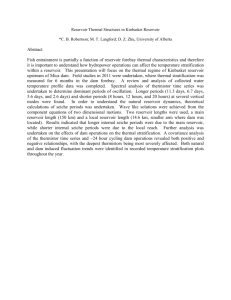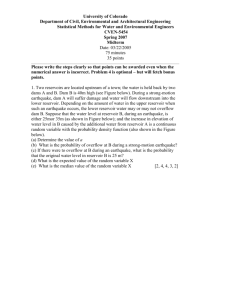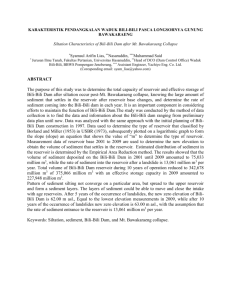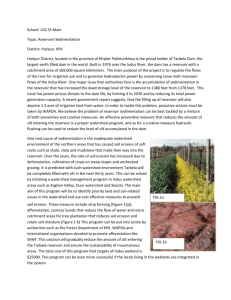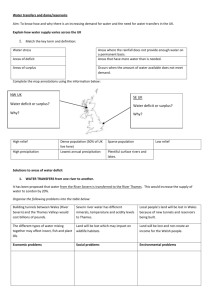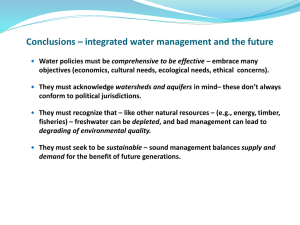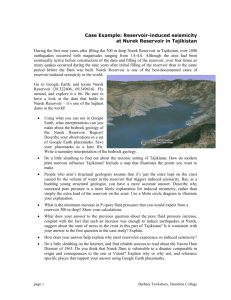Reservoir Modeling and Storage Capacity
advertisement
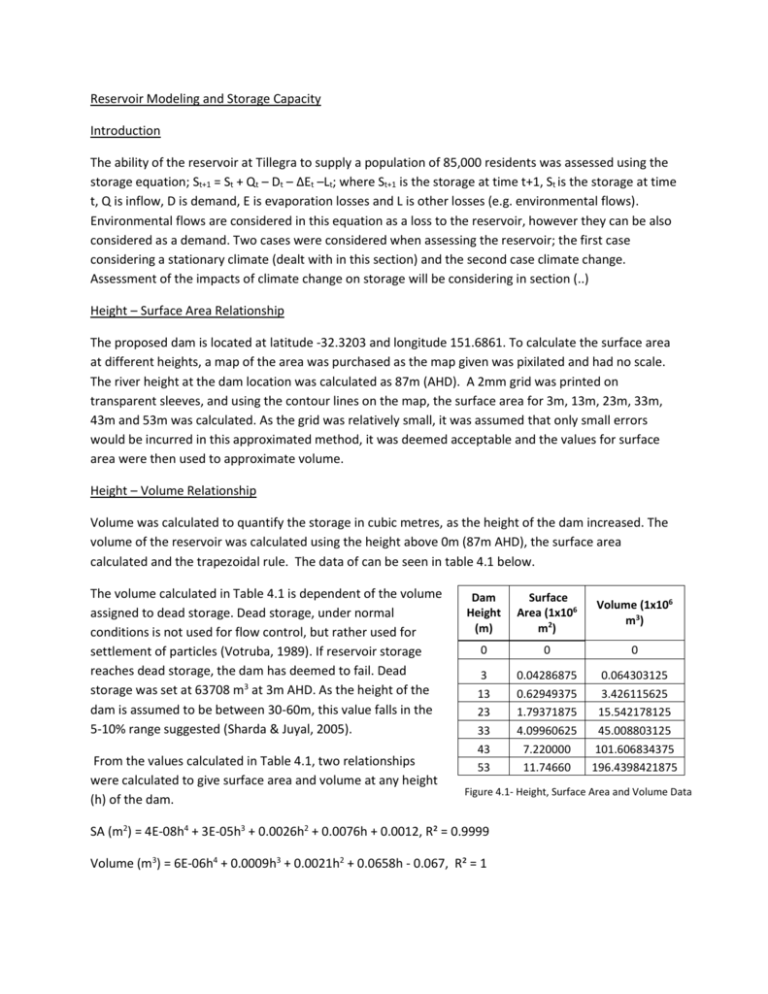
Reservoir Modeling and Storage Capacity Introduction The ability of the reservoir at Tillegra to supply a population of 85,000 residents was assessed using the storage equation; St+1 = St + Qt – Dt – ΔEt –Lt; where St+1 is the storage at time t+1, St is the storage at time t, Q is inflow, D is demand, E is evaporation losses and L is other losses (e.g. environmental flows). Environmental flows are considered in this equation as a loss to the reservoir, however they can be also considered as a demand. Two cases were considered when assessing the reservoir; the first case considering a stationary climate (dealt with in this section) and the second case climate change. Assessment of the impacts of climate change on storage will be considering in section (..) Height – Surface Area Relationship The proposed dam is located at latitude -32.3203 and longitude 151.6861. To calculate the surface area at different heights, a map of the area was purchased as the map given was pixilated and had no scale. The river height at the dam location was calculated as 87m (AHD). A 2mm grid was printed on transparent sleeves, and using the contour lines on the map, the surface area for 3m, 13m, 23m, 33m, 43m and 53m was calculated. As the grid was relatively small, it was assumed that only small errors would be incurred in this approximated method, it was deemed acceptable and the values for surface area were then used to approximate volume. Height – Volume Relationship Volume was calculated to quantify the storage in cubic metres, as the height of the dam increased. The volume of the reservoir was calculated using the height above 0m (87m AHD), the surface area calculated and the trapezoidal rule. The data of can be seen in table 4.1 below. The volume calculated in Table 4.1 is dependent of the volume assigned to dead storage. Dead storage, under normal conditions is not used for flow control, but rather used for settlement of particles (Votruba, 1989). If reservoir storage reaches dead storage, the dam has deemed to fail. Dead storage was set at 63708 m3 at 3m AHD. As the height of the dam is assumed to be between 30-60m, this value falls in the 5-10% range suggested (Sharda & Juyal, 2005). From the values calculated in Table 4.1, two relationships were calculated to give surface area and volume at any height (h) of the dam. Dam Height (m) Surface Area (1x106 m2) Volume (1x106 m3) 0 0 0 3 13 23 33 43 53 0.04286875 0.62949375 1.79371875 4.09960625 7.220000 11.74660 0.064303125 3.426115625 15.542178125 45.008803125 101.606834375 196.4398421875 Figure 4.1- Height, Surface Area and Volume Data SA (m2) = 4E-08h4 + 3E-05h3 + 0.0026h2 + 0.0076h + 0.0012, R² = 0.9999 Volume (m3) = 6E-06h4 + 0.0009h3 + 0.0021h2 + 0.0658h - 0.067, R² = 1 Both these equations have R2 approximately equal to one, which suggests both equations are good representations of the trend in the data and can be assumed to have little error. The relationship between the plotted data and the equations can be seen in Tables 1 and 2 in appendix. References -Votruba, L, 1989, Developments in Water Science, Accessed 4/8/11, [Online Publication] http://books.google.com/books?id=j8dIlPJITH0C&printsec=frontcover#v=onepage&q&f=false -Sharda and Juyal, 2005, Water Harvesting Techniques, Design of Small Dams and Hydraulic Complements, Accessed 4/8/11, [Online Publication] Available at http://www.docstoc.com/docs/68290300/WATER-HARVESTING-TECHNIQUES--DESIGN-OF-SMALLDAMS-AND-HYDRAULIC Appendix Surface Area (m2) Vs Reservoir Height (m) 14 y = 4E-08x4 + 3E-05x3 + 0.0026x2 + 0.0076x + 0.0012 R² = 0.9999 Area(1x106 m2) 12 10 8 Surface Area(1x106 m2) 6 Poly. ( Surface Area(1x106 m2)) 4 2 0 0 20 40 Reservoir Height (m) 60 Volume (m3) Vs Reservoir Height (m) 250 y = 6E-06x4 + 0.0009x3 + 0.0021x2 + 0.0658x - 0.067 R² = 1 Volume (1x106 m3) 200 150 Volume( 1x106m3) 100 Poly. (Volume( 1x106m3)) 50 0 0 20 40 60 Reservoir Height (m)

